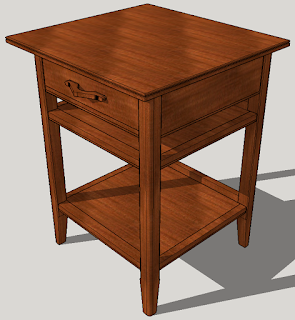 |
| Original design without cross stretchers |
I decided half way through the build to add stretchers in front of each shelf, still giving a slender appearance to the shelves. I also incorporated M&T joints for the lower rear cross member. Previously both rear upstands had just been glued to the shelf - the lower one was now part of the structure. This required me to hand cut mortises to suit these after the sides had been glued up.
 |
| New design with cross stretchers |
The assemblies would not fit on a mortiser, a router table and a router had nothing to register against as all measurements had to come from the now glued up inside faces. I think even a Domino would struggle once the side assemblies had been glued up.
So I hand cut the mortises.
The process of hand cutting mortises is very simple and comprises the following:
- Mark out the position of each mortise preferably with a marking knife to sever the wood fibres
- Under cut a knife line with a regular bench chisel
- Use the mortise chisel to chop out an initial shallow trench but stay shy of the cross-cut knife lines. The reason for this as it's so easy when driving the wedge shaped blade into the wood and go beyond your knife lines
- Remove the chopped out waste
- Register the mortise chisel in the shallow trench and chop out in 1/8" deep passes until you achieve the desired depth.
- When the full depth has been reached go back to the cross-cut knife lines and finish the mortise to the knife lines.
This is very simple to do and results in very accurate mortises. I encourage everybody to at least try this process once as it is very satisfying.
The same process that was used to produce the side aprons and shelf supports was used to produce the cross stretchers, table saw to establish the shoulders, tenoning jig to cut the tenon cheeks to width, cut to the tenons to width and shape.
 |
| Tenons cut and adjusted for width |
The rear aprons were made and these components have two tenons per side. I designed it this way to miss the tenons in the side aprons.
 |
| Rear apron with two tenons Side tenon with 1 tenon |
 |
| Leg in position (Shown in Xray mode on Sketchup) |
Again all the stretchers had a bead routed on the lower face and the other edges had a shallow round over routed in. The exception to the round over were the bottom cross-member forming the drawer slot. This was just chamfered with a block plane.
 |
| Finished cross-stretchers and lower rear aprons |






